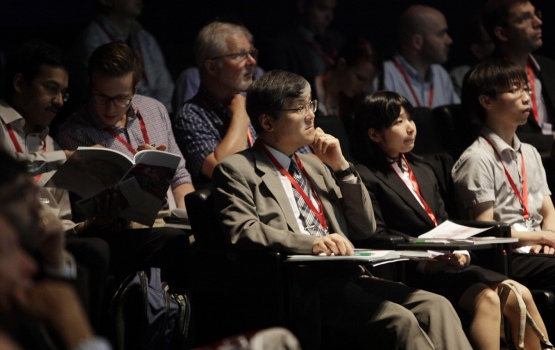Evolving Medical Robotics with the Hamlyn Symposium 2014
by Jo Seed
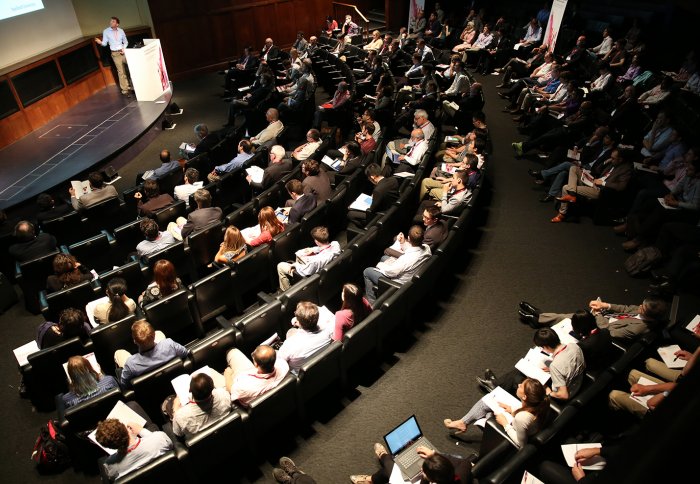
Over 250 surgeons & engineers gathered at the annual Hamlyn Symposium this week to try their hand at the latest developments in medical robotics.
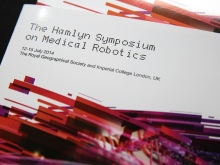 On Sunday 13th and Monday 14th July, Surgeons from across the globe assembled at the Royal Geographical Society to listen to talks, attend workshops and to take part in demos and simulations of the various medical robots being developed today. The event was hosted by Imperial’s Hamlyn Centre for Robotic Surgery, one of the Institute of Global Health Innovation’s (IGHI) four centres of excellence.
On Sunday 13th and Monday 14th July, Surgeons from across the globe assembled at the Royal Geographical Society to listen to talks, attend workshops and to take part in demos and simulations of the various medical robots being developed today. The event was hosted by Imperial’s Hamlyn Centre for Robotic Surgery, one of the Institute of Global Health Innovation’s (IGHI) four centres of excellence.
With the UK government’s announcement of robotics and autonomous systems (RAS) being “one of the Eight Great Technologies that can potentially propel the nation’s future growth”, we have increasingly seen a united effort across all disciplines to boost medical robotics into the forefront of current medical practice.
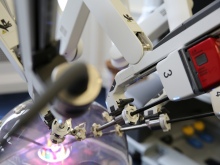 Robotic surgery offers many benefits to patients compared to open surgery, including shorter periods in hospital, reduced pain, discomfort and scarring, smaller incisions, resulting in reduced risk of infection, a decrease in blood loss and transfusions and a faster recovery time and return to normal activities.
Robotic surgery offers many benefits to patients compared to open surgery, including shorter periods in hospital, reduced pain, discomfort and scarring, smaller incisions, resulting in reduced risk of infection, a decrease in blood loss and transfusions and a faster recovery time and return to normal activities.
Other drivers for healthcare robots are the ageing population and the increasing importance of quality-of-life, independence and autonomy for those with chronic illnesses and disabilities.
The theme for this year’s symposium was “Beyond Surgery - Independence and Quality of Life” with a speaker line-up of leading scientists and engineers in collaborative robotics, navigation and image guidance.
The keynote lecture was delivered by Professor Toshio Fukuda of Nagoya University, who enlightened us on his experiences with Micro and Nano Robotics Systems. Professor Homayoon Kazerooni of the University of California, Berkeley focused on developments on the lower extremity exoskeleton system. Professor Rajni Patel, Director of Engineering at CSTAR, shared his expertise and recent advances on haptics and teleoperation. Robert Riener, Professor for Sensory-Motor Systems at the Department of Health Sciences and Technology at ETH Zurich outlined the future steps for robots and their potential use in new therapies and treatment modalities. This year’s Storz-Hopkins lecture was delivered by Professor Lee Swanstrom, Clinical Professor of Surgery at the Oregon Health and Science University, who provided his insight and vision on the emerging technologies that might influence the future of surgery.
Guests also had the opportunity to attend workshop programmes on the days pre- and pro-ceding the Symposium. Topics covered included cognitive surgical robotics; MR-compatible robotics and interventions; paediatrics; imaging; flexible access surgery and open platforms for robotic surgery.
Unique to this year’s symposium was the launch of the micro-robotics design challenge funded by the newly established Hamlyn Centre Micro-Engineering Facility as part of the EPSRC Capital for Great Technologies in RAS. This workshop brought together both clinicians and engineers for addressing the key challenges related to micro-robotics manufacturing, control and in vivo deployment. Participants will have 9 months to design, manufacture, and validate their proof-of-concept studies with support from the Hamlyn Centre. The winners will be announced during next year’s Symposium.
Two of the workshops were organised in conjunction with the new EPSRC-NIHR Healthcare Technology Co-operatives (HTC) Partnership Award on Devices for Surgery and Rehabilitation. In collaboration with the Trauma HTC at University Hospital Birmingham NHS Foundation Trust, the Wearable and Assistive Robots workshop had a line-up of international leaders in the field.
The workshop provided a forum to bring together researchers, engineers, and healthcare practitioners from a diverse range of disciplines to present the current state-of-the-art in wearable and assistive robots. It also covered some of the major technical challenges and unmet healthcare demands that can potentially reshape the future of wearable and assistive robots.
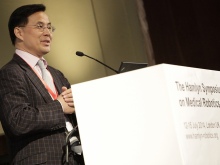 “Medical robotics are approaching a tipping point, moving beyond the odd few who are currently using this new technology to becoming standard surgical practice. The Hamlyn Symposium provided an excellent platform to showcase the cutting-edge developments in robotic surgery that can help boost its usage and in turn, reshape the future of healthcare worldwide.” Said Professor Guang-Zhong Yang, Director of the Hamlyn Centre within the Institute of Global Health Innovation (IGHI).
“Medical robotics are approaching a tipping point, moving beyond the odd few who are currently using this new technology to becoming standard surgical practice. The Hamlyn Symposium provided an excellent platform to showcase the cutting-edge developments in robotic surgery that can help boost its usage and in turn, reshape the future of healthcare worldwide.” Said Professor Guang-Zhong Yang, Director of the Hamlyn Centre within the Institute of Global Health Innovation (IGHI).
I was delighted to be part of another successful Symposium. I was particularly excited by the momentum applied by the community in establishing an open platform for medical robots, with which the academic institutions and leading industrial players can work together to explore common problems and new research challenges in medical robotics.
– Professor the Lord Darzi
Director, IGHI
“I was delighted to be part of another successful Symposium. I was particularly excited by the momentum applied by the community in establishing an open platform for medical robots, with which the academic institutions and leading industrial players can work together to explore common problems and new research challenges in medical robotics. It is encouraging to see that many of these workshops have resulted in further on-going interactions among the participants and potential joint research grants or publications” said Professor the Lord Ara Darzi, Head of the Division of Surgery and Director of the Institute of Global Health Innovation at Imperial.
More information on the Hamlyn Centre and its research can be found here
Join the debate and follow the Hamlyn Centre on Twitter @ICLHamlyn
For more photos of the event, check out our Flickr pages here.
Article text (excluding photos or graphics) © Imperial College London.
Photos and graphics subject to third party copyright used with permission or © Imperial College London.
Reporter
Jo Seed
Institute of Global Health Innovation
